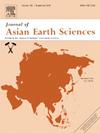Structural and lithological controls on the evolution of ore-forming fluids during the formation of the Chaihulanzi gold deposit, NE China
IF 2.7
3区 地球科学
Q2 GEOSCIENCES, MULTIDISCIPLINARY
引用次数: 0
Abstract
The Chaihulanzi gold deposit, located along the northern margin of the North China Craton, is an example of detecting the controls on the complexity of orogenic gold systems. This deposit consists of a series of gold lodes hosted in graphite-schist, gneiss, and porphyrite and is controlled by NW- to NWW-directed faults. The graphite-schist-hosted gold lodes contain pyrite-arsenopyrite-dominated polymetallic sulfides, whereas the gneiss- and porphyrite-hosted lodes are characterized by pyrite-pyrrhotite-dominated polymetallic sulfides. Despite variations in ore-minerals, these lodes exhibit similar quartz-sericite ± carbonate-chlorite alteration. In the dilatational faults, the δ34S values of pyrite from graphite-schist-hosted lodes from + 0.4 to + 6.5 ‰, whereas pyrite from gneiss-hosted lodes have δ34S values ranging from −3.5 to + 8.5 ‰. In the compressional faults, pyrite from porphyrite-hosted lodes shows δ34S values between + 2.3 to + 4.4 ‰. The broader range of δ34S values from dilatational-lodes compared to compressional-lodes can be attributed to varying fluid-rock interactions and fluid pressure fluctuations. The contrasting ore minerals and sulfur isotope are linked to the interaction of ore-forming fluids with different host rocks in complex structural and lithological settings. Specifically, the relatively positive δ34S in pyrite from graphite-schist-hosted lodes may result from the fluid reduction due to reaction with graphite-schist. The Pb isotope of pyrite with 206Pb/204Pb, 207Pb/204Pb, and 208Pb/204Pb ratios of 18.51–22.13, 15.69–16.54, and 37.92–43.59, respectively, support the hypothesis of Pb contamination of the host rocks. This study underscores the detailed influence of structural settings and lithologies on the complexity of ore-forming fluid compositions and provides valuable insights for guiding regional exploration.

求助全文
约1分钟内获得全文
求助全文
来源期刊

Journal of Asian Earth Sciences
地学-地球科学综合
CiteScore
5.90
自引率
10.00%
发文量
324
审稿时长
71 days
期刊介绍:
Journal of Asian Earth Sciences has an open access mirror journal Journal of Asian Earth Sciences: X, sharing the same aims and scope, editorial team, submission system and rigorous peer review.
The Journal of Asian Earth Sciences is an international interdisciplinary journal devoted to all aspects of research related to the solid Earth Sciences of Asia. The Journal publishes high quality, peer-reviewed scientific papers on the regional geology, tectonics, geochemistry and geophysics of Asia. It will be devoted primarily to research papers but short communications relating to new developments of broad interest, reviews and book reviews will also be included. Papers must have international appeal and should present work of more than local significance.
The scope includes deep processes of the Asian continent and its adjacent oceans; seismology and earthquakes; orogeny, magmatism, metamorphism and volcanism; growth, deformation and destruction of the Asian crust; crust-mantle interaction; evolution of life (early life, biostratigraphy, biogeography and mass-extinction); fluids, fluxes and reservoirs of mineral and energy resources; surface processes (weathering, erosion, transport and deposition of sediments) and resulting geomorphology; and the response of the Earth to global climate change as viewed within the Asian continent and surrounding oceans.
 求助内容:
求助内容: 应助结果提醒方式:
应助结果提醒方式:


